When and how to plant beets with seeds: step by step instructions for beginner gardeners
Beets are so popular that they are grown on all continents except Antarctica. And this is not surprising, because this root vegetable is not only rich in vitamins and minerals, but also edible from the roots to the tips of the leaves.
Cultivation of a healthy vegetable is within the power of even a novice gardener. In the article, we will tell you in detail about when and how to plant beets with seeds.
The content of the article
Selection and preparation of seeds for planting
Varieties beets divided into early, mid-season and late (depending on the ripening period).
Of the early varieties, Early Wodan, Carillon, Red ball, Mona, Egyptian and Gribovskaya flat, Action, Nastenka are popular. The harvest of such beets can be harvested in 80-110 days from the moment of germination.
Mid-season varieties include Bordeaux-237, Sonata, Crimson ball, Valya, Detroit, Cold-resistant 19. These beets will ripen in 110-130 days.
Late beets are represented by such varieties as Saladnaya, Matrona, Cylindra. Late-ripening beets are harvested 130-145 days after germination.
Sow the culture with both dry and presoaked seeds. More friendly and faster germination is provided by soaked and germinated seed material. This is easily explained, because beet seeds are dense and shriveled and they need a lot of moisture and time to germinate.
For soaking, use ordinary warm water.
Important! Sprouted seeds are sown in well-moistened soil, otherwise the sprouts will die.
The prepared seeds will sprout in about 3-4 days. Dry - in 12-15 days. The fresher the seeds, the better germination they give.
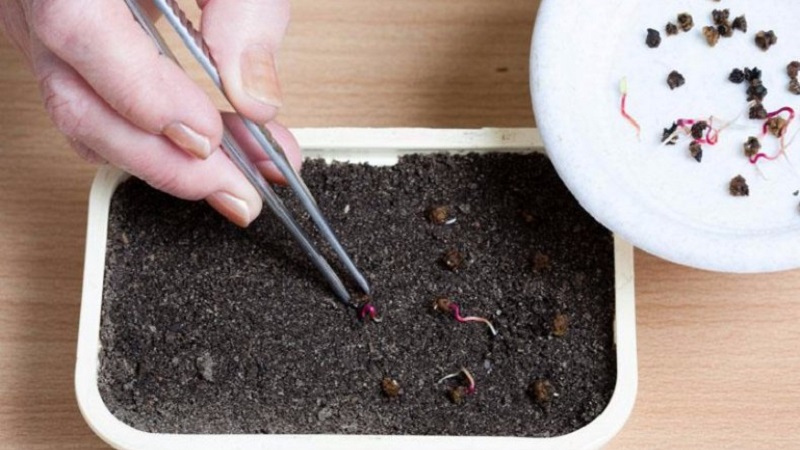
Dates of sowing beet seeds
Planting dates affect germination and quality indicators.
Choosing a landing date
When to start sowing beets outdoors? The specific date is determined by the climate of the region and the variety of the root crop. For early varieties, the soil should be warmed up to + 8-10 ° C. Cold-resistant varieties can be sown at soil temperatures of + 5-6 ° C.
Need to know. Beet seedlings are sensitive to low temperatures. Cold snap and frost can ruin the entire crop.
Mid-season and late varieties are sown in early June. By the end of the summer cottage season, they are fully ripe.
Determination of landing dates according to the lunar calendar
You can choose a specific sowing date based on the lunar calendar. All root crops are sown with the waning moon.
The most favorable days in 2019:
- May - 23;
- June - 9-11.
- The full moon is considered the worst time for any sowing work.
Crop rotation rules
The same crop rotation rules apply to beet crops as to other root crops. For planting do not choose the same place for more than two years in a row. Re-use the area for beets after 4-5 years.
Recommended predecessors and neighbors
Next to what to plant beets? Good predecessors of beets are legumes, cabbage, tomato, cucumber, eggplant.
Root crops love to grow along the edges of the garden. In the central part, good neighbors will be carrots, onions, celery, kohlrabi, cucumbers, cauliflower.
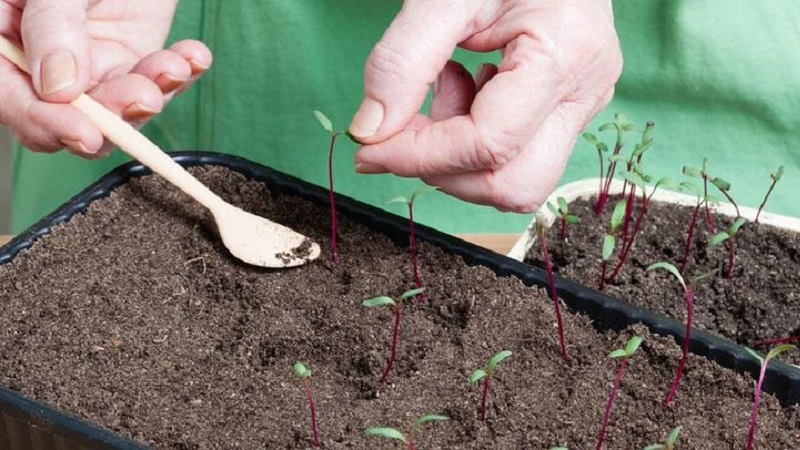
How to properly plant beet seeds
Competent placement of plants in the garden will allow you to get the maximum possible yield per unit area.
Sowing instructions
Soak or dry seeds should be properly planted in pre-moistened soil. On the bed, 2-3 grooves are cut with an interval of 15-20 cm. A distance of 40-50 cm is maintained between the beds. The seeds are laid out in furrows at a distance of 8-10 cm from each other.
You should not plant seeds deeply. The sprouts will not have enough oxygen and seedlings will not appear. And finely seeded seeds will not have enough moisture.
The choice of the optimum sowing depth depends on the soil. The seed is buried in heavy soil by 2 cm, in light soil - by 3-4 cm.
Experienced farmer tips:
- beets are sown in moist and warm soil, the seeds need moisture and heat for germination;
- the seedlings are carefully thinned out, the thickening of the plants will negatively affect the yield;
- the distance between the rows should not be too large, weeds will begin to actively grow in the free space;
- fresh manure is not used as fertilizer.
What mistakes to avoid:
- Inexperienced summer residents plant beet seeds too deep into the ground, fearing that it will not have enough moisture. As a result, seeds do not germinate due to lack of oxygen.
- At the first thinning of seedlings, excess plants are pinched or cut with scissors. Pulling them out can damage the roots of healthy shoots.
- Beets are sensitive to lack of sunlight. A well-lit place is chosen for sowing.
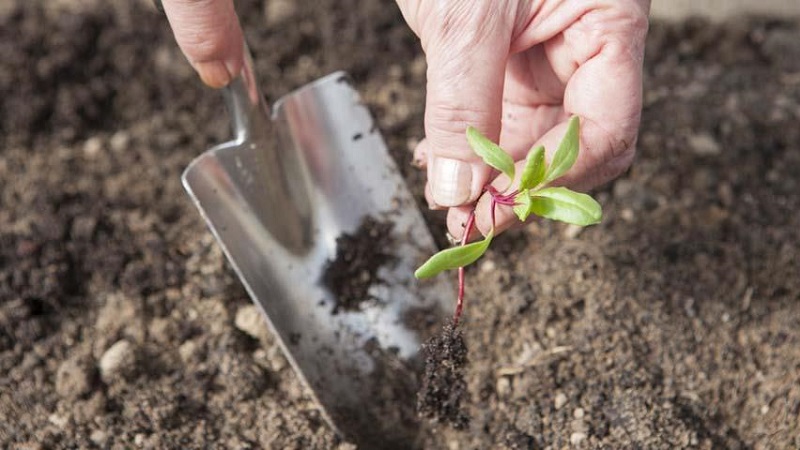
Beet planting patterns
The answer to the question, at what distance from each other to plant seeds depends on the chosen method of planting root crops.
Experienced gardeners use several schemes, choosing the most convenient for themselves in the future:
- The so-called belt method is an alternation of wide row spacings with rows of crops. The grooves are laid along the site with an interval of 40-50 cm.A distance of 8-10 cm is left between the seeds.
- String method. The beds are formed at a distance of 25-30 cm from each other. Seed holes are made across each bed.
- Landing tape. Beet seeds, glued to a tape of tissue paper, are laid out in furrows and covered with earth.
- Growing beets through seedlings. Seedlings are prepared 1-2 months before planting in open ground. Plants are planted at intervals of 10 cm and a distance of 15-25 cm between rows.
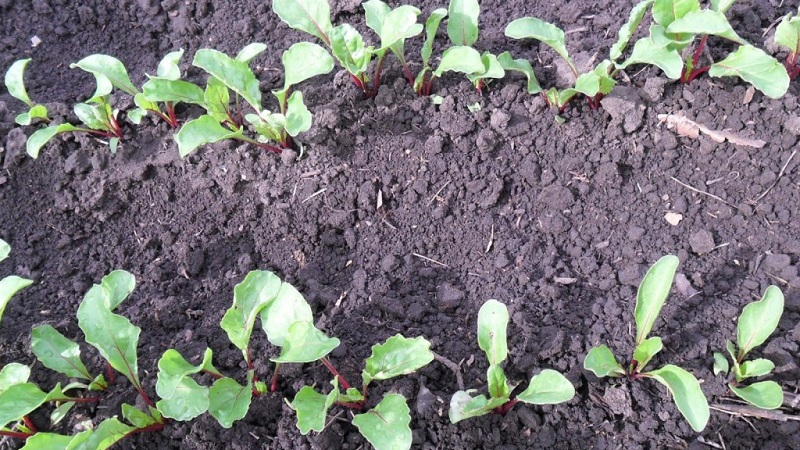
Care
After the emergence of seedlings, planting should be thinned regularly. Further care consists in watering, fertilizing, loosening the soil, removing weeds, and protecting against pests.
Top dressing
After the first thinning, the plants are fed with mineral fertilizers. Fertilizer is applied in a liquid or dry state when the first true leaves appear.
Average dosage: 30 g of ammonium nitrate, 80 g of superphosphate, 35 g of potassium chloride per 10 liters of water.This volume of liquid is used for watering 15 running meters of the row. Superphosphate and potash fertilizers replace ash well.
Fertilizers are applied for the second time 20 days after the first feeding.
Important! Root crops are fertilized until mid-July. Later feeding leads to the accumulation of nitrates in the vegetable.
Experienced gardeners once a month water the beets with a weak solution of sodium chloride. This increases the sweetness of the vegetable and enriches the soil with sodium.
Watering
Particular attention is paid to watering during the period of growing green mass. After the formation of leaves, watering is reduced. Excess moisture leads to cracking of root crops, which worsens keeping quality vegetable in winter.
Excessive moisture is also bad for the taste of beets.
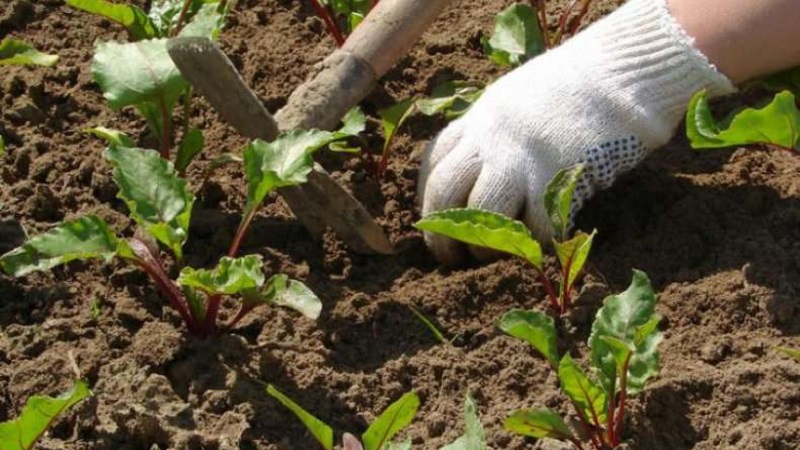
Loosening the soil and removing weeds
In August, some summer residents stop caring for beets, believing that the job has already been done. This approach is erroneous, since at this time the root crop is gaining mass and still needs oxygen, light and moisture. Loosening is especially necessary if the beets are growing in heavy soil.
Pests and diseases
The greatest danger of pests and diseases is at the initial stage of plant growth. The following insects significantly reduce the crop yield:
- The beet weevil is a black beetle 1-1.5 cm long, the body of which is covered with scales. The pest hibernates in the soil where the beets were grown. It feeds on young plants, causing their death. Can completely destroy crops.
- The beet flea is a small black beetle 1–2 mm long. The pest spends the winter under the remains of plants and in the spring greedily eats young beet greens.
- The beet miner fly is a gray insect 6–8 mm long. Lays eggs in beet leaves, forming so-called mines (bulges) with larvae inside. Affected plants die or produce poor crops.
Beets are not insured against diseases either. Let's list the most common ones:
- Korneed. A disease affecting seedlings. Caused by pathogenic microorganisms. It is not difficult to recognize the disease. A constriction forms on the stem, the root darkens and rots. Such seedlings often die. The surviving sprouts develop slowly later. The harvest is small and poorly stored. The choice of high-quality seed material will help protect yourself from disease.
- Fomoz. It manifests itself on root crops in the form of dry rot. During storage, such roots decompose quickly, forming foci of infection. The mushroom overwinters on plant debris, in roots during storage. The disease is seed-borne; root-eater develops on the seedlings of such seeds.
- Cercosporosis - one of the most dangerous diseases of the beet crop. The causative agent of the disease is a fungus that infects leaves. On the greens, spots with a gray bloom are formed, leading to the death of the plant. The causative agent of the disease spends the winter in infected plant parts. Beet seed can also be a source of infection.

Pest and disease control
Timely removal of weeds, observance of crop rotation, tillage of the soil in autumn with the introduction of fertilizers helps to avoid damage to crops by pests and diseases.
The sowing site is chosen away from the plants, which can be a source of diseases and dangerous insects.
Need to know. Plant residues are a wintering place for dangerous insects. Cleaning the site in the fall and burning plant residues deprives pests of shelter for the winter.
When choosing seed material, varieties and hybrids that are resistant to diseases are chosen.
If the disease has appeared, the affected leaves are cut off and removed from the site.

Read also:
Why beetroot juice is useful: we prepare a healing drink ourselves.
The best ways to harvest beet leaves for the winter and recipes from them.
Conclusion
Even a novice gardener can handle the cultivation of beets from seeds. Soaking and preparing seeds for planting improves germination and allows for an early harvest. In the open field, planting and caring for beets does not require much effort.